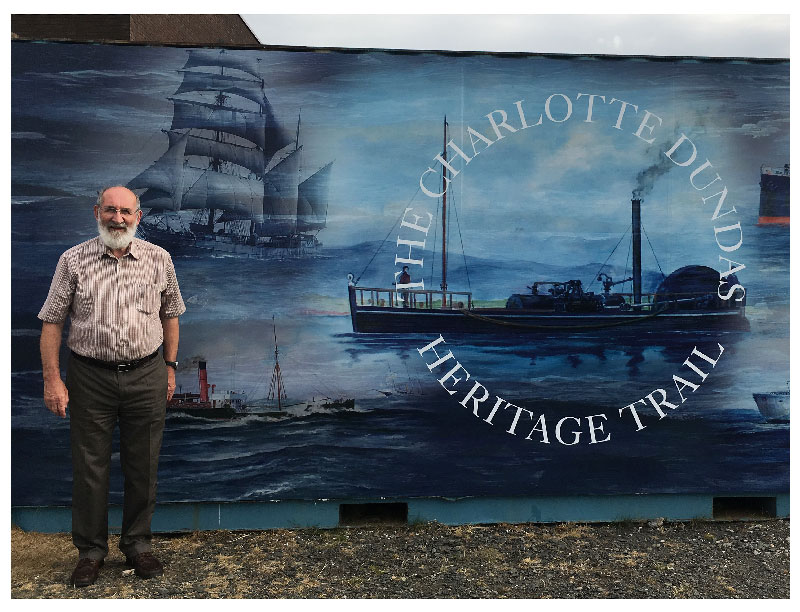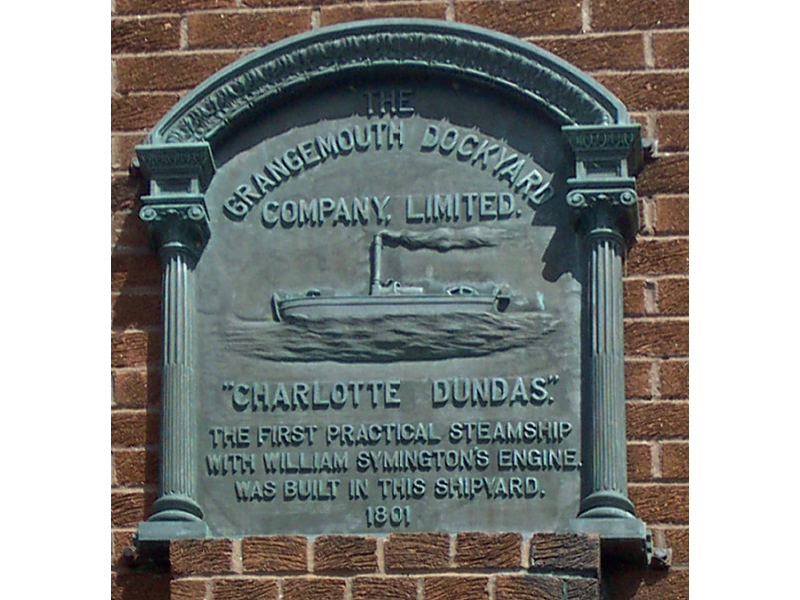Shipbuilding at Grangemouth
Soon after the canal opened and long before it was completed from coast to coast, boat builders had established yards in the village. A fleet of canal barges and other vessels were built to service the demand from local merchants keen to cash in on the advantages offered by the new waterway. In 1782 the first ship, Jean and Janet, was completed by J Welsh and further vessels were registered the following year.Alexander Hart who built the Charlotte Dundas for Symington was working from a boatyard first established in 1788 by John Cowie. The second Charlotte Dundas was built in John Allan’s yard on the north side of Middle Street.
In 1811 Lord Thomas Dundas ordered the construction of a dry dock which included four buildings and two repair berths 350ft in length. These facilities allowed local shipyards to build bigger ships including ocean-going vessels. In 1844 the yard became the Grangemouth Dockyard Company. Later in the century, the local trade was dominated by the shipbuilding Adamson family. In late Victorian times, Grangemouth built canal barges, square-rigged sailing ships, ocean-going vessels and canal boats, together with light craft destined for service all over the British Empire. When shipbuilding came to an end in the 1970s ship refitting continued until the mid-1980s.
Grangemouth Boatyard’s Maritime Legacy
In addition to The Charlotte Dundas, a range of other notable vessels were constructed in Grangemouth.
The extensive list includes the Ilma (1885) a three masted Barquentine which saw service in Australia and New Zealand, the passenger cargo ship Koonya (1898) which assisted Shackleton’s Antartic expedition-ship Nimrod in 1908, and the famous Flower Class Corvette’s including HMS Celandine and Cyclamen.
We are indebted to Grangemouth-based marine engineer and nautical artist Tom Robertson for accurately portraying the appearance of these vessels, and for his generousity and invaluable contribution to The Charlotte Dundas Heritage Trail. We are also greatly indebted to Ian Scott for providing detailed historical information and imagery, helping us to chart the history of the Charlotte Dundas and of the Falkirk and Grangemouth area.
Commemorative cards and fridge magnets featuring Tom’s paintings of Grangemouth vessels can be found in the Helix Visitor Centre and in other locations.


The boatyard office in 1947

The boatyard

Boatyard workers
The Grangemouth Dockyard Company built warships and refitted hundreds of other vessels including destroyers, corvettes, submarines and merchant ships for the British and foreign navies.
The 20th Century
During World War I the Admiralty requisitioned the port and named it HMS Rameses. Expansion continued through World War II when the boatyard was extended up to North Bridge Street.
Helped by the proximity of the foundries and boilermakers, the Grangemouth Dockyard Company was able to build warships and refit hundreds of other vessels including destroyers, corvettes, submarines and merchant ships for the British and foreign navies. Ships of up to 5,500 deadweight tons were built, and once completed, were launched sideways, due to the narrowness of the River Carron. 1952 saw the launch of the 500th ship.
More recent years would see a new road called ‘Forth-Clyde Way’ replace the section of the canal that originally ran next to the boatyard office. The boatyard office itself was replaced by a more modern building which still bears a commemorative plaque in honour of The Charlotte Dundas.
Further information on the history of the boatyard and Grangemouth can be found in Robert Porteous’ book: Grangemouth’s Modern History.


-
Did you know? Ships of up to 5,500 tons were launched into the River Carron
-
Did you know? Over 500 vessels were built in Grangemouth, many of which would see service all over the world
-
Did you know? During WW1 the dockyard was requisitioned by the admiralty and named HMS Rameses

